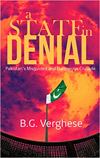|
Home |
Misconceived and mischievousEulogised by the Home Minister, the book "Religious Demography in India", is packed with bogus sociology and dangerous prejudice. By B G Verghese The Week, July, 2003 A recent book launch had Mr L.K.Advani, the nation’s Home Minister and Deputy Prime Minister, eulogise the volume “Religious Demography in India” authored by A.P.Joshi, M.D. Srinivas and J.K.Bajaj of the Centre for Policy Studies, Chennai. The authors classify the people of India as being either “Indian Religionists” (Hindu, Sikh, Buddhist, Jain and tribal) or Non-IR (Muslim and Christian), sheep and goats, we and they and, implicitly, Indian and foreign. This is a well established thesis articulated by Savarkar, Hegdewar and Golwalkar and now assiduously preached by the Sangh Parivar and Hindutvadis extolling “cultural nationalism”, an exclusivist political creed with little reverence for true faith and tradition. Mr Advani looks upon demography as realpolitik. His Foreword quotes Augustus Comte, the French philosopher, as saying that “Demography is Destiny”. Why? Because knowing, predicting and controlling the social and economic pressures created by our changing demographic patterns is essential for the noble task of nation-building”. Certainly, the ghosts of Partition still haunt memory. Yet, rather than build anew after that trauma, the Home Minister speaks of the “strategic pressures” of India’s external and internal demography and calls for rigorous and continuous observation and analysis of the changing demography of different religious in various regions. This, he believes is of “paramount importance in maintaining the integrity of our borders, and peace, harmony and public order within the country”. Mr Narendra Modi is keeping careful watch in Gujarat and, in another context, the MMA in Pakistan. Both represent birds of a feather on either side of the border. The Parivar invented the two-nation theory and obviously still clings to it. Some nation-building. The statistics, meticulously compiled, are culled from over 100 years of Census data. The Home Minister’s Foreword now advocates that the Census organization take note of this volume. This indicates “several areas where detailed data needs to be collected and that of the previous censuses reorganized” so that future editions of this book are “more complete and rigorous”.
“Religious Demography of India” speaks of “pressures” building on IRs from Christianity and, more particularly, Islam, with their population “suffering” a decline from 86.64% to 85.09 % between the Census years of 1901 and 1991. The thesis that unfolds is that IRs enjoy overwhelming dominance in northwestern, central, western and southern India (less Kerala). But in “the heartland and eastern regions” comprising UP, Bihar, and Assam, IRs are “under great pressure”, especially in several border districts. In the border regions of J&K, the Northeast, Goa, Kerala, Lakshadweep and Nicobar the IRs constitute a third or less of the population or are in a minority. The inference drawn from this analysis is that India’s timeless “cultural and civilisational homogeneity” is threatened by those who look on it “as a source of oppression and backwardness”. This ideological prejudice is manifest in “protection of distinctive ways of life of religious minorities”, especially those belonging to Islam and Christianity. So there it is. India’s pluralism and diversity that the Constitution proudly proclaims, is the enemy within, a cancer that must be contained if not eradicated. The volume contains some bogus sociology. Sample this. Indigenous faiths lost ground during centuries of Islamic rule and Western dominance. With decolonisation, the share of Asian and African populations in the world rose sharply after 1951 largely to neutralise the gains made by European people during the previous hundred years. Wrong. The population explosion was caused by modern medicine and measures to combat famine. The authors do not explain why, if IRs constitute a single happy family, Buddhists and Jains suffered persecution and numerical decline over wide areas of India in the transition to the medieval period. Nor does it tell us why caste “backwardness and oppression” disgracefully linger to this day, compelling many trapped in a caste time warp to seek liberation by opting out through change of faith. Ambedkar warned that this would happen 50 years ago. Nor again does this thesis explain the unpunished pogrom against Sikhs in Delhi in 1984.
The Constitution of India, to which the Home Minister is pledged, proclaims a common and equal citizenship. “Religious Demography in India” would deny this basic feature. It views all Indians, not as citizens, but as so many potentially antagonistic religious categories. The Constitution celebrates and protects India’s rich diversity and tradition of accommodation that has been its great civilisational strength. The authors of this volume, however, see this as a political and cultural threat. The HRD Ministry has recently constituted a Task Force to improve all levels of education in India. Among its terms of reference is one that would define and promote a “national culture”. Is this the “cultural nationalism” of Hindutva and the Sangh Parivar ? India will not be bludgeoned into a cultural sameness by sundry cavemen. The blurb on the dust jacket of “Religious Demography of India” calls on India to start afresh and “get into the task of nation building with an abiding passion”. We have been warned. |
||||
| back to the top | |||||
HOME | ABOUT THE AUTHOR | LIST OF ARTICLES | CONTACT | BOOKS See also AsianConversations.com 11-C Dewan Shree Apartments, 30 Ferozeshah Rd, New Delhi 110001, India
|


